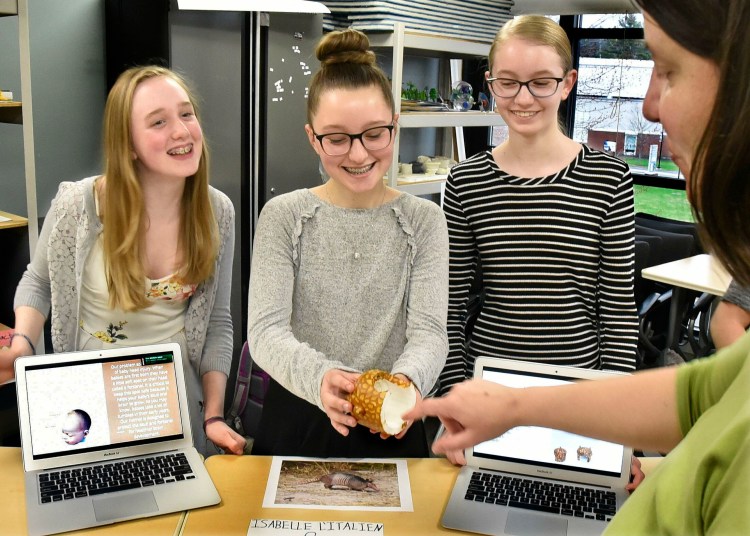WATERVILLE — Over the past four months, students from Messalonskee Middle School have worked to design models of erosion pavers, constellation flashlights, tiny homes, toddler kayaks and more.
They presented their research — including prototypes made with a 3-D printer — Tuesday evening at Thomas College’s Center for Innovation and Education.

Madison Wills, left, of Messalonskee Middle School, shows the kayak she created with a 3-D printer to Molly Hay of Athens Community School during a workshop at Thomas College in Waterville on Tuesday. Morning Sentinel photo by David Leaming
Members of Regional School Unit 18’s gifted and talented program have worked under the guidance of teachers-in-training at Thomas College for the past four months to develop practical solutions to global challenges in the fields of science, technology, engineering, arts and math (STEAM). Thomas students hosted a kick-off workshop and taught four classes at Messalonskee Middle School starting in February.
RSU 18 includes Belgrade, China, Oakland, Rome and Sidney.
“(The goal was) to create an authentic product with a real-world impact and that involved 3-D printing,” said Kate Cook, an assistant professor of education at Thomas College who helped oversee the project.
Tamiko Paquette, a teacher for RSU 18’s gifted and talented program, said she was looking for new ways to integrate STEAM topics in her curriculum and reached out to Cook to collaborate this winter. Thirty-two students from Messalonskee Middle School and China Middle School and 18 kids affiliated with Belgrade Central School and Waterville’s Alfond Youth Center participated in the design challenge, according to Cook. At Thomas, 24 undergraduates were involved.
Sixth-graders Madison Wills and Drake Brunelle, both from Messalonskee Middle School, presented on Tuesday different prototypes of a device that would enable toddlers to kayak with an adult.
Brunelle said students were posed questions about what designs, features and materials would yield the best and safest product. His design featured a half-kayak extension with a toddler seat in the middle. Its bow formed a v-shape, which allows it to connect to the pointed tail of an adult kayak, and its stern came to a point to maintain the look and dynamics of the regular kayak. The toddler extension attaches to the handles of the adult kayak, Brunelle said.

Madison Wills of Messalonskee Middle School created a small kayak with a 3-D printer at a workshop at Thomas College in Waterville on Tuesday. Morning Sentinel photo by David Leaming
Wills’ design involved a round raft-like extension with a removable buckle-in seat that could be replaced with larger models as the child grows. The floating seat connects to the rear of an adult kayak with three ropes. It also includes a baby camera and monitor so parents can see what the child is doing without having to spin around in the kayak and risk tipping over. She said that her final proposal was similar to her initial vision but with a few tweaks.
“This one is wider so that it’s more stable,” Wills said, comparing the final product to three of her earlier prototypes that were on display. “Children move a lot, so you don’t want the kayak to be too tippy. This is good for a child’s natural movement.”
She said it would cost “around $150, depending on the quality of the materials used and how big it is.”
Both Wills and Brunelle agreed that a technique called thermoforming was the most environmentally sound and cost friendly option of the four that they researched. Thermoforming involves “putting plastic in a shell and using heat to mold it into a shape,” Brunelle said.
Representatives from L.L. Bean attended Tuesday’s fair to listen to presentations.

A human skull cap made by Messalonskee Middle School students with a 3-D printer replicates the armor of an armadillo in a biomimicry project at Thomas College in Waterville on Tuesday. Morning Sentinel photo by David Leaming
Across the room, seventh graders Brynn Lilly, Isabelle L’Italien and Lily Mitchell described adapting the armor of an armadillo into a helmet to prevent head injuries for babies, a process that utilized biomimicry.
“Biomimicry is basically an imitation of aspects of nature to create a solution to complex problems,” said L’Italien.
The trio designed a piece of headgear with a proposed foam interior and hollow circular cutout beneath the shell to create an air space that would cushion the blow of an infant’s fall.
“You have to be careful because their brains are developing,” said Lilly.
L’Italien said that they had the idea to adapt an armadillo’s bony exterior for practical use before they thought of the idea of a helmet for babies.
Cook said that the arrangement was mutually beneficial: Education majors at Thomas learned how to develop STEAM-oriented curricula, while the younger students got to pilot a hybrid, hands-on course that had never before been offered at RSU 18. Participants seemed to agree.
“This challenge was really fun to do,” said Wills. “It pushed us to our best abilities and to do better than we already do.”
Though Cook is leaving Thomas College after the school year, Paquette said the “collaboration will continue” next year between Thomas College and RSU 18.
The Perloff Foundation donated a Flash Forge 3-D printer to the middle school last May, according to Paquette.
Send questions/comments to the editors.



Success. Please wait for the page to reload. If the page does not reload within 5 seconds, please refresh the page.
Enter your email and password to access comments.
Hi, to comment on stories you must . This profile is in addition to your subscription and website login.
Already have a commenting profile? .
Invalid username/password.
Please check your email to confirm and complete your registration.
Only subscribers are eligible to post comments. Please subscribe or login first for digital access. Here’s why.
Use the form below to reset your password. When you've submitted your account email, we will send an email with a reset code.